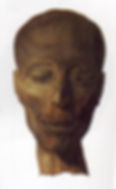Halloween Special: Mummies! Unwrapping Napoleon’s Egyptian Campaign
- Robin K. Floyd
- Oct 26, 2022
- 4 min read
Editor's note: Young Jane Austen would not have had an opportunity to go trick-or-treating, since the customs now associated with Halloween are largely an American elaboration of Irish-Catholic customs around the harvest festival of Samhain. She might have enjoyed a Guy Fawkes' Day bonfire, or have bobbed for apples and then peeled the apple or counted its seeds as a way to tell her fortune, but there would have been no costumes and no candy. Instead, she would have probably recognized All Hallows' Eve and All Saints' Day, liturgical celebrations of, well, all saints named and un-named, or all of those who have been "hallowed" by the church. This tradition includes meditating on deceased family members as well.
In the absence of black cats and witches, we thought we'd focus on another haungting figure associated with Halloween about which - surprisingly - young Jane Austen might have known. Napoleon was arguably scarier to Englishmen during the Regency than anything Stephen King has dreamed up, and his exploits were front page news during Austen's adolescence - including artifacts from Egypt like mummies.
Have you ever wondered how much Jane Austen knew about the mummies of Ancient Egypt? You might be surprised by how much knowledge on the topic would have been available to her when she was a teenager.
We must open by acknowledging that the time period commonly known as "Ancient Egypt" spans nearly thirty centuries. Ancient Egyptians could study their own culture as a kind of ancient history. For example, Khaemweset (c.1281-c.1225 BCE), the fourth son of Ramesses II (1279-1213 BCE), became the first archeologist by exploring the mummies left by previous Egyptian dynasties. His discoveries inspired contemporary embalmers to improve their craft as they continued to mummify the dead for another thousand years! Given the length of this history, we could not hope to scrape the surface of this immense topic in one tiny blog post, so we are not even trying.
Instead, we are only focusing upon what the people of Regency England knew about Ancient Egypt, a fascination that led to "Egyptomania." (Of course, though mummies and pyramids would have been very exotic to the inhabitants of Jane’s world, they would have been a matter of fact for Egyptians.)

In 1798, when Jane would have been about eleven, the French government considered attacking England but Napoleon suggested that they should strike Egypt instead. From a point of strategy, this was a way to cut off England’s land route to India, but Napoleon saw this as more than just a military campaign. He was after knowledge as well.

Louis-François, Baron Lejeune, The Battle of the Pyramids (1808). Public Domain, Wikicommons
In addition to taking his troops and their horses, Napoleon brought along scholars, engineers, cartographers, and the like, with a secret mission to record and study everything they could find. After the successful Battle of the Pyramids (July 21, 1798) and a less than successful Battle of the Nile (August 1-3, 1798), Napoleon established the world’s first Egyptology society, called Institut d’Egypte. For a short while, he even participated in some of the scientific inquiries before abandoning Egypt altogether in 1799 and returning home, where he declared himself the winner of the war that continued on without him until 1801.

George Arnald, The Battle of the Nile (1825-27) Public Domain, Wikicommons
When Napoleon left Egypt, the scholars remained there to work. They measured everything, made maps, and copied every bit of art they could find. They even drew pictures of how the modern habitants dressed as well as portraits of the mummies themselves! The collection of their work would be compiled into a book called Description de L’Egypte. The book was so comprehensive, that viewing it even today one can imagine they are right there in Egypt seeing that world as it was in the late 18th century. The book was published in a series of volumes, the first of which became available to the public in 1809, when Jane was about 22. The publication of these volumes provided Europe with a glimpse into life in Egypt, modern and ancient.

The Great Sphinx of Giza in Description de l'Egypte (Panckoucke edition), Planches, Antiquités, volume V (1823).
The most famous and most significant artifact that the French scholars encountered was, of

course, the Rosetta Stone. The stone itself is a bit of a thank-you note that is written in Greek and two forms of Egyptian, the informal demotic and the formal hieroglyphs. Deciphering the hieroglyphs took a long time but part of the code was cracked in 1814, three years before Jane’s death, by a British scientist named Thomas Young.
The Rosetta Stone, Wikicommons
England technically won the war that Napoleon discarded and their victory was followed with a fascination with all things Egypt. Wedgewood even designed teapots and sugar bowls sporting crocodiles and other Egyptian motifs.

Wedgewood Factory, covered sugar bowl, 1805
English fascination with Egyptian artifacts had been a hobby for private collectors throughout the eighteenth-century, but Napoleon's exploits reinvigorated the trend. You could almost say he brought it back to life. . .

BOO! And Happy Halloween from all of us at JASP!
Illustration of a mummy from Description de l'Egypte
To learn more, check out Egyptomania by Bob Brier. For more frighteningly interesting reading, check out our past blogs on Frankenstein and Northanger Abbey!
Spend a Day Out With Emma!

Join us Dec. 3 in Chapel Hill, N.C., as we celebrate "Emma" with a day of presentations, crafts, holiday shopping and more, all leading up to Kate Hamill's new stage adaptation of the novel by PlayMakers Repertory Company.
Click to REGISTER TODAY!




